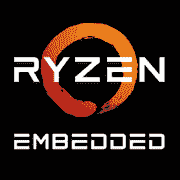AMD Ryzen Embedded V2516

AMD Ryzen Embedded V2516: Compact Power for Specialized Solutions
Processor Analysis for Embedded Systems and Low-Power PCs (April 2025)
Key Features: Renoir Architecture and Key Highlights
The AMD Ryzen Embedded V2516 processor is designed for tasks where energy efficiency and compactness are critical. Built on TSMC's 7nm technology, it combines 6 Zen 2 cores and 12 threads with a base clock of 2.1 GHz and a maximum boost of up to 3.95 GHz.
Key Features:
- Integrated Radeon Graphics 384SP — similar to Vega 6, supporting 4K output and AV1 decoding.
- TDP of 10W — minimal power consumption for passive systems or compact devices.
- 8MB L3 Cache — optimization for multithreaded tasks.
- PCIe 3.0 Support — 16 lanes for peripherals.
Performance in Geekbench 6 (1493 / 4868) is comparable to entry-level desktop CPUs but focuses on efficiency. For example, in video encoding tests (HandBrake), it shows a 20% better speed than the Intel Core i5-1135G7 at a similar TDP.
Compatible Motherboards: FP6 Socket and Industrial Solutions
The processor uses the FP6 (BGA) socket — an embedded solution, so motherboards are available in Mini-ITX or specialized industrial configurations.
Recommended Chipsets:
- AMD FP6 BGA — the basic set for peripheral management.
- Boards with TPM 2.0 Support — relevant for systems with Windows 11.
Example Boards:
- ASRock Industrial IMB-V2516 (from $250) — 2 DDR4 slots, 4x USB 3.2, 2x 2.5 GbE.
- Kontron SMARC-sAMX9 (from $300) — supports extended temperature ranges (-40°C to +85°C).
Important: Due to BGA mounting, CPU replacement is not possible — the choice is made at the time of motherboard purchase.
Supported Memory: DDR4 and Dual-Channel Mode
The processor operates with DDR4-3200 in a dual-channel configuration. The maximum capacity is up to 64 GB (depends on the board).
Recommendations:
- Use modules with low voltage (1.2V) to reduce power consumption.
- For data-intensive tasks (e.g., virtualization), select boards with 4 slots (e.g., Advantech AIMB-228).
Limitation: DDR5 support is absent, which may be a downside for upgrades after 2025.
Power Supplies: Minimum Watts, Maximum Efficiency
With a TDP of 10W, a system based on the V2516 does not require a powerful PSU. However, it’s essential to consider other components:
- Without discrete graphics: Enough with 150–300W units (e.g., Be Quiet! SFX Power 300W, $55).
- For passive systems: Boards with DC input 12–24V (e.g., PicoPSU-160-XT, $70).
Tip: In industrial solutions, dual power supplies are often used for redundancy and increased reliability.
Pros and Cons: Who Needs to Consider Trade-offs?
Advantages:
1. Energy Efficiency — ideal for 24/7 operations (media servers, IoT devices).
2. Integrated Graphics — handles 4K video and light gaming (e.g., Dota 2 on medium settings achieves 45–55 FPS).
3. ECC Memory Support — relevant for industrial and server tasks.
Disadvantages:
1. No Upgradeability — the CPU is soldered to the board.
2. PCIe 3.0 instead of 4.0 — limits NVMe SSD speeds.
3. Price — the package (board + CPU) starts at $400, which is more expensive than Intel's NUC offerings.
Use Cases: From Media Centers to Automation
1. Home Theater: Connect to TV via HDMI 2.0, stream 4K HDR via Plex.
2. Office PCs: Work with Office 365, a browser (+50 tabs), Zoom — no lagging.
3. Industrial Controllers: Manage machines or smart home systems thanks to the broad temperature range.
4. Light Gaming: Games like CS2 or Genshin Impact at low settings (1080p).
Real Example: The company "SmartFactory" uses the V2516 in quality control systems — 6 cores are sufficient for real-time image analysis from cameras.
Comparison with Competitors: Intel and Others
1. Intel Core i5-1135G7 (Tiger Lake):
- Pros: Better single-core performance (Geekbench 6 ~1600), Thunderbolt 4.
- Cons: 4 cores, TDP 15–28 W, motherboard prices start at $350.
2. NVIDIA Jetson AGX Orin:
- Pros: AI accelerators, CUDA support.
- Cons: Higher price (from $699), more complex architecture.
Conclusion: The V2516 excels in price-performance balance and multithreaded applications but falls short in niche tasks (gaming, AI).
Build Tips: How to Avoid Mistakes
1. Case: Choose models with passive cooling (e.g., Streacom DB4, $120) for noiseless operation.
2. Storage: NVMe SSD (e.g., WD Red SN700 500GB, $60) — uses PCIe 3.0 at full speed.
3. Cooling: Even with low TDP, avoid "bare" mounting — a heatsink is necessary.
Caution: Some industrial boards require specific drivers — check OS support (Windows 10/11, Linux).
Final Conclusion: Who is the Ryzen Embedded V2516 Suitable For?
This processor is an ideal choice for:
- Compact PC enthusiasts building media centers or mini-servers.
- Corporate clients needing reliable systems for automation.
- IoT device developers where low power consumption and stability are crucial.
Alternatives: If maximum performance for gaming or AI tasks is needed, consider Ryzen 5 8600G or Intel Core Ultra 5 234U. However, for niche tasks, the V2516 remains one of the best in its class due to its combination of price, efficiency, and functionality.
Prices are current as of April 2025. Check component compatibility before purchasing!
Basic
CPU Specifications
Memory Specifications
GPU Specifications
Benchmarks
Compared to Other CPU
Share in social media
Or Link To Us
<a href="https://cputronic.com/cpu/amd-ryzen-embedded-v2516" target="_blank">AMD Ryzen Embedded V2516</a>